Enhanced LDM for Next-Generation Digital Broadcasting Transmission
Abstract
1. Introduction
2. Overview of the Traditional LDM Scheme
3. Proposed En-LDM Scheme
3.1. System Model
3.1.1. En-LDM Transmitter
3.1.2. En-LDM Receiver
3.2. Channel Capacity Analysis
3.2.1. Analysis for LDM
3.2.2. Analysis for En-LDM
3.2.3. BICM Capacity Analysis
4. Compute and Simulation Results
4.1. Spectral Efficiency Calculation
4.2. Simulation Results
5. Conclusions
Author Contributions
Funding
Institutional Review Board Statement
Informed Consent Statement
Data Availability Statement
Conflicts of Interest
References
- Digital Video Broadcasting (DVB); Frame Structure Channel Coding and Modulation for a Second Generation Digital Terrestrial Television Broadcasting System (DVB-T2), V1.4.1. July 2015. Available online: https://www.etsi.org/deliver/etsi_en/302700_302799/302755/01.04.01_60/en_302755v010401p.pdf (accessed on 28 February 2021).
- Error-Correction, Data Framing, Modulation and Emission Methods for Digital Terrestrial Television Broadcasting. June 2015. Available online: https://www.itu.int/dms_pubrec/itu-r/rec/bt/R-REC-BT.1306-7-201506-S!!PDF-E.pdf (accessed on 28 February 2021).
- Lee, J.-Y.; Park, S.-I.; Kwon, S.; Lim, B.-M.; Ahn, S.; Hur, N.; Kim, H.M.; Kim, J. Layered Division Multiplexing for ATSC 3.0: Implementation and Memory Use Aspects. IEEE Trans. Broadcast. 2019, 65, 496–503. [Google Scholar] [CrossRef]
- Zhang, L.; Li, W.; Wu, Y.; Salehian, K.; LaFleche, S.; Hong, Z.; Park, S.-I.; Kim, H.M.; Lee, J.-Y.; Hur, N.; et al. Using Layered-Division-Multiplexing to Deliver Multi-Layer Mobile Services in ATSC 3.0. IEEE Trans. Broadcast. 2018, 65, 40–52. [Google Scholar] [CrossRef]
- Lee, J.; Park, S.I.; Kwon, S.; Lim, B.; Ahn, S.; Hur, N.; Kim, H.M.; Jeon, S.; Gomcz-Barquero, D. Field Testing of LDM and SHVC Broadcast in ATSC 3.0. In Proceedings of the 2018 IEEE International Symposium on Broadband Multimedia Systems and Broadcasting (BMSB), Valencia, Spain, 6–8 June 2018; pp. 1–5. [Google Scholar]
- Regueiro, C.; Barrueco, J.; Montalban, J.; Eizmendi, I.; Velez, M. Improving LDPC decoding performance for ATSC 3.0 LDM profiles. In Proceedings of the 2017 IEEE International Symposium on Broadband Multimedia Systems and Broadcasting (BMSB), Cagliari, Italy, 7–9 June 2017; pp. 1–5. [Google Scholar]
- Park, S.; Lee, J.; Kwon, S.; Lim, B.; Ahn, S.; Kim, H.M.; Jeon, S.; Lee, J.; Simon, M.; Aitken, M.; et al. ATSC 3.0 Physical Layer Modulation and Coding Performance Analysis. In Proceedings of the 2018 IEEE International Symposium on Broadband Multimedia Systems and Broadcasting (BMSB), Valencia, Spain, 6–8 June 2018; pp. 1–3. [Google Scholar]
- Garro, E.; Gimenez, J.J.; Gomez-Barquero, D.; Park, S. Pilot optimization for mobile services in ATSC 3.0. In Proceedings of the 2016 IEEE International Symposium on Broadband Multimedia Systems and Broadcasting (BMSB), Nara, Japan, 1–3 June 2016; pp. 1–5. [Google Scholar]
- Park, S.; Lim, B.; Kim, Y.; Kim, H.M.; Lee, S.H.; Choi, W.; Lee, D.; Lee, S.K.; Shin, Y.W. ATSC 3.0 LDM-based mobile performance under HPHT metropolitan environment. In Proceedings of the 2016 IEEE International Symposium on Broadband Multimedia Systems and Broadcasting (BMSB), Nara, Japan, 1–3 June 2016; pp. 1–3. [Google Scholar]
- Park, S.I.; Lee, J.-Y.; Myoung, S.; Zhang, L.; Wu, Y.; Montalban, J.; Kwon, S.; Lim, B.-M.; Angueira, P.; Kim, H.M.; et al. Low Complexity Layered Division Multiplexing for ATSC 3.0. IEEE Trans. Broadcast. 2016, 62, 233–243. [Google Scholar] [CrossRef]
- Zhang, L.; Li, W.; Wu, Y.; Salehian, K.; Angueira, P.; Montalban, J.; Kim, H.M.; Park, S.; Lee, J.; Wang, X. Two-layer mobile service performance in LDM-based ATSC 3.0 system. In Proceedings of the 2016 IEEE International Symposium on Broadband Multimedia Systems and Broadcasting (BMSB), Nara, Japan, 1–3 June 2016; pp. 1–7. [Google Scholar]
- Cho, S.; Hwang, Y.; Myung, S.; Yang, K. Low-Complexity Decoding Algorithms for the LDM Core Layer at Fixed Receivers in ATSC 3.0. IEEE Trans. Broadcast. 2016, 63, 293–303. [Google Scholar] [CrossRef]
- Kwon, S.; Park, S.I.; Lee, J.; Lim, B.; Kim, H.M.; Hur, N.; Kang, J. ATSC 3.0 LDM/TDM performance comparison in fixed reception environment. In Proceedings of the 2017 IEEE International Symposium on Broadband Multimedia Systems and Broadcasting (BMSB), Cagliari, Italy, 7–9 June 2017; pp. 1–3. [Google Scholar]
- Zhang, L.; Li, W.; Wu, Y.; Xue, Y.; Sousa, E.; Park, S.-I.; Lee, J.-Y.; Hur, N.; Kim, H.-M. Using Non-Orthogonal Multiplexing in 5G-MBMS to Achieve Broadband-Broadcast Convergence with High Spectral Efficiency. IEEE Trans. Broadcast. 2020, 66, 490–502. [Google Scholar] [CrossRef]
- Zhang, L.; Wu, Y.; Li, W.; Park, S.; Lee, J.; Hur, N.; Kim, H. Using Layered-Division-Multiplexing to Achieve Enhanced Spectral Efficiency in 5G-MBMS. In Proceedings of the 2019 IEEE International Symposium on Broadband Multimedia Systems and Broadcasting (BMSB), Jeju, Korea, 5–7 June 2019; pp. 1–7. [Google Scholar]
- Islam, M.S.; Patwary, M.; Tait, R.; Peytchev, E. Layer division multiplexing for 5G DL transmission within ultra-dense heterogeneous networks. In Proceedings of the 2020 IEEE 91st Vehicular Technology Conference (VTC2020-Spring), Antwerp, Belgium, 25–28 May 2020; pp. 1–7. [Google Scholar]
- Zhang, L.; Wu, Y.; Li, W.; Salehian, K.; LaFleche, S.; Wang, X.; Park, S.I.; Kim, H.M.; Lee, J.-Y.; Hur, N.; et al. Layered-Division Multiplexing: An Enabling Technology for Multicast/Broadcast Service Delivery in 5G. IEEE Commun. Mag. 2018, 56, 82–90. [Google Scholar] [CrossRef]
- Kim, H.J.; Kwon, S.; Kim, H.; Bae, J.; Hur, N. Performance Analysis of LDM and TDM systems for Three PLPs in DVB-T2. In Proceedings of the 2020 International Conference on Electronics, Information, and Communication (ICEIC), Barcelona, Spain, 19–22 January 2020; pp. 1–3. [Google Scholar]
- Ahn, S.; Park, S.; Lee, J.; Kwon, S.; Liml, B.; Kim, H.M.; Hur, N.; Wu, Y.; Zhang, L.; Li, W.; et al. Performance Evaluation of ATSC 3.0 Mobile Service with LDM/TDM Under TU-6 Channel. In Proceedings of the 2018 IEEE International Symposium on Broadband Multimedia Systems and Broadcasting (BMSB), Valencia, Spain, 6–8 June 2018; pp. 1–9. [Google Scholar]
- Park, S.-I.; Lee, J.-Y.; Lim, B.-M.; Kwon, S.; Seo, J.-H.; Kim, H.M.; Hur, N.; Kim, J. Field Comparison Tests of LDM and TDM in ATSC 3.0. IEEE Trans. Broadcast. 2017, 64, 637–647. [Google Scholar] [CrossRef]
- Kwon, S.; Park, S.-I.; Lee, J.-Y.; Lim, B.-M.; Ahn, S.; Kang, J. Detection Schemes for ATSC 3.0 Transmitter Identification in Single Frequency Network. IEEE Trans. Broadcast. 2019, 66, 229–240. [Google Scholar] [CrossRef]
- Lee, J.-Y.; Park, S.-I.; Kwon, S.; Lim, B.-M.; Kim, H.M.; Montalbán, J.; Angueira, P.; Zhang, L.; Li, W.; Wu, Y.-Y.; et al. Multiple Service Configurations Based on Layered Division Multiplexing. IEEE Trans. Broadcast. 2016, 63, 267–274. [Google Scholar] [CrossRef]
- Wang, H. Discussion on Layer Division Multiplexing Technology and Application. Adv. Telev. Eng. 2016, 132–135. [Google Scholar] [CrossRef]
- Chernock, R.; Whitaker, J.C.; Wu, Y. ATSC 3.0—The Next Step in the Evolution of Digital Television. IEEE Trans. Broadcast. 2017, 63, 1–4. [Google Scholar] [CrossRef]
- Zhang, L.; Hong, Z.; Li, W.; Wu, Y.; Salehian, K.; Gomez-Barquero, D.; Angueira, P.; Montalban, J.; Kim, H.M.; Park, S.; et al. Capacity analysis of LDM-based DTV system with flexible MIMO configuration. In Proceedings of the 2016 IEEE International Symposium on Broadband Multimedia Systems and Broadcasting (BMSB), Nara, Japan, 1–3 June 2016; pp. 1–7. [Google Scholar]
- Li, W.; Wu, Y.; Laflèche, S.; Salehian, K.; Zhang, L.; Florea, A.; Park, S.; Lee, J.; Kim, H.; Hur, N.; et al. Coverage study of ATSC 3.0. In Proceedings of the 2017 IEEE International Symposium on Broadband Multimedia Systems and Broadcasting (BMSB), Cagliari, Italy, 7–9 June 2017; pp. 1–5. [Google Scholar]
- Park, S.I.; Montalbán, J.; Zhang, L.; Gil, U.; Wu, Y.; Angulo, I.; Salehian, K.; Rong, B.; Li, W.; Kim, H.M.; et al. Hardware Implementation and Complexity Analysis of Layered Division Multiplexing (LDM) System for ATSC 3.0. In Proceedings of the NAB Broadcast Engineering Conference, Las Vegas, NV, USA, 5–10 April 2013; pp. 77–81. [Google Scholar]
- Shannon, C.E. A Mathematical Theory of Communication. Bell Syst. Tech. J. 1948, 27, 379–423. [Google Scholar] [CrossRef]
- Zhang, L.; Wu, Y.; Li, W.; Kim, H.M.; Park, S.; Angueira, P.; Montalban, J.; Velez, M. Channel capacity distribution of Layer-Division-Multiplexing system for next generation digital broadcasting transmission. In Proceedings of the 2014 IEEE International Symposium on Broadband Multimedia Systems and Broadcasting, Beijing, China, 25–27 June 2014; pp. 1–6. [Google Scholar]
- Regueiro, C.; Montalban, J.; Barrueco, J.; Velez, M.; Angueira, P.; Wu, Y.; Zhang, L.; Park, S.-I.; Lee, J.-Y.; Kim, H.M. LDM Core Services Performance in ATSC 3.0. IEEE Trans. Broadcast. 2016, 62, 244–252. [Google Scholar] [CrossRef]
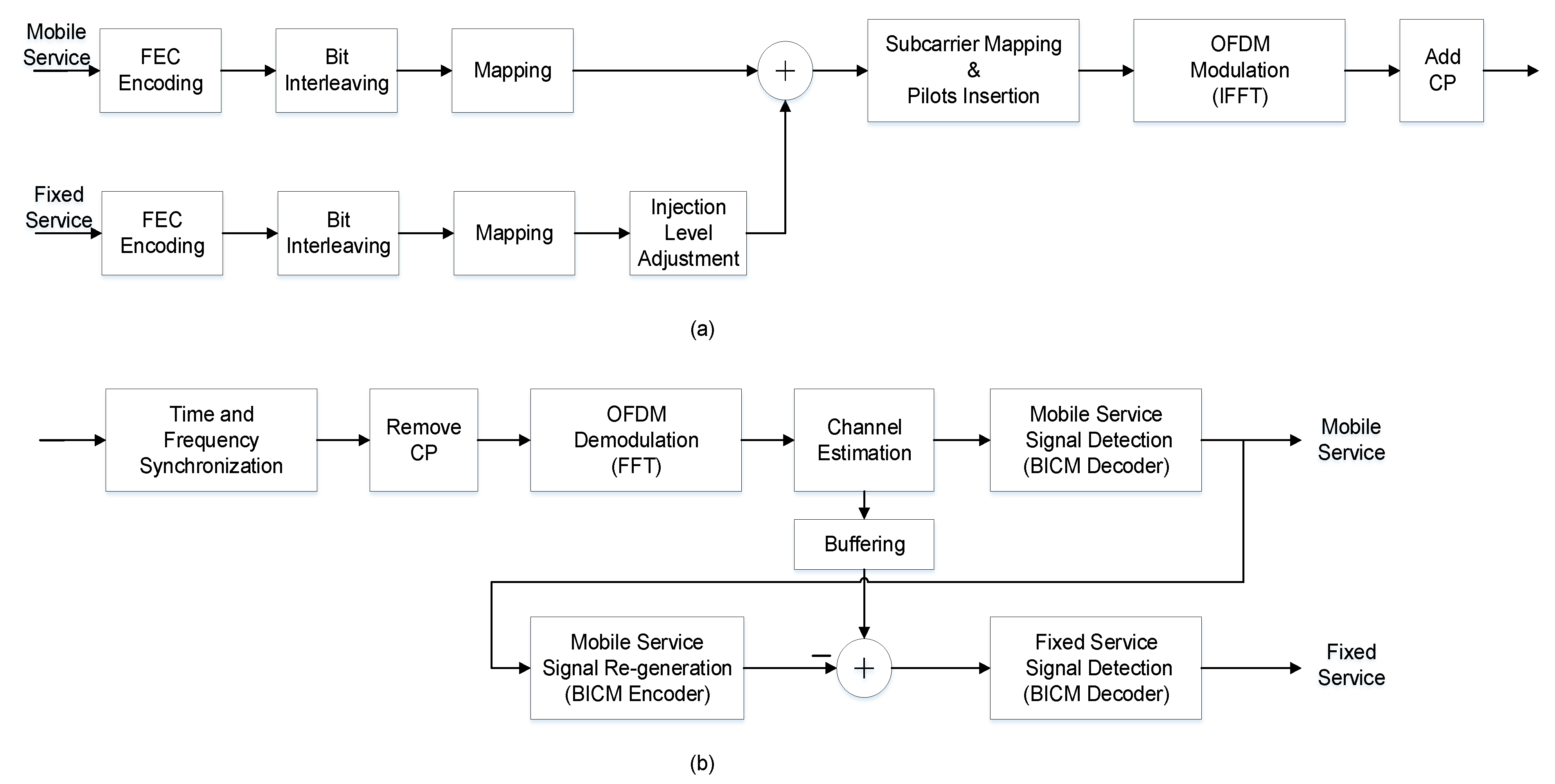

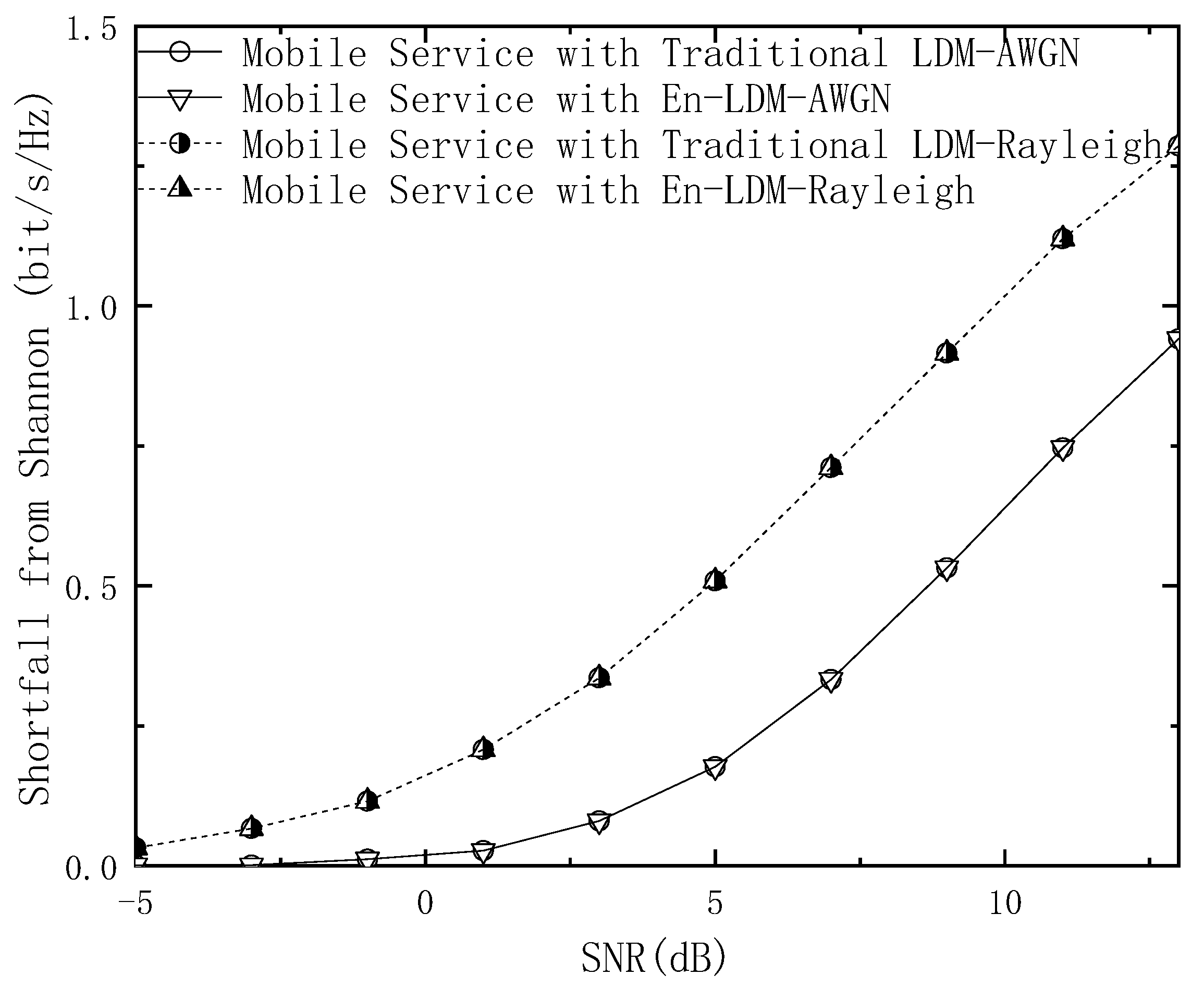
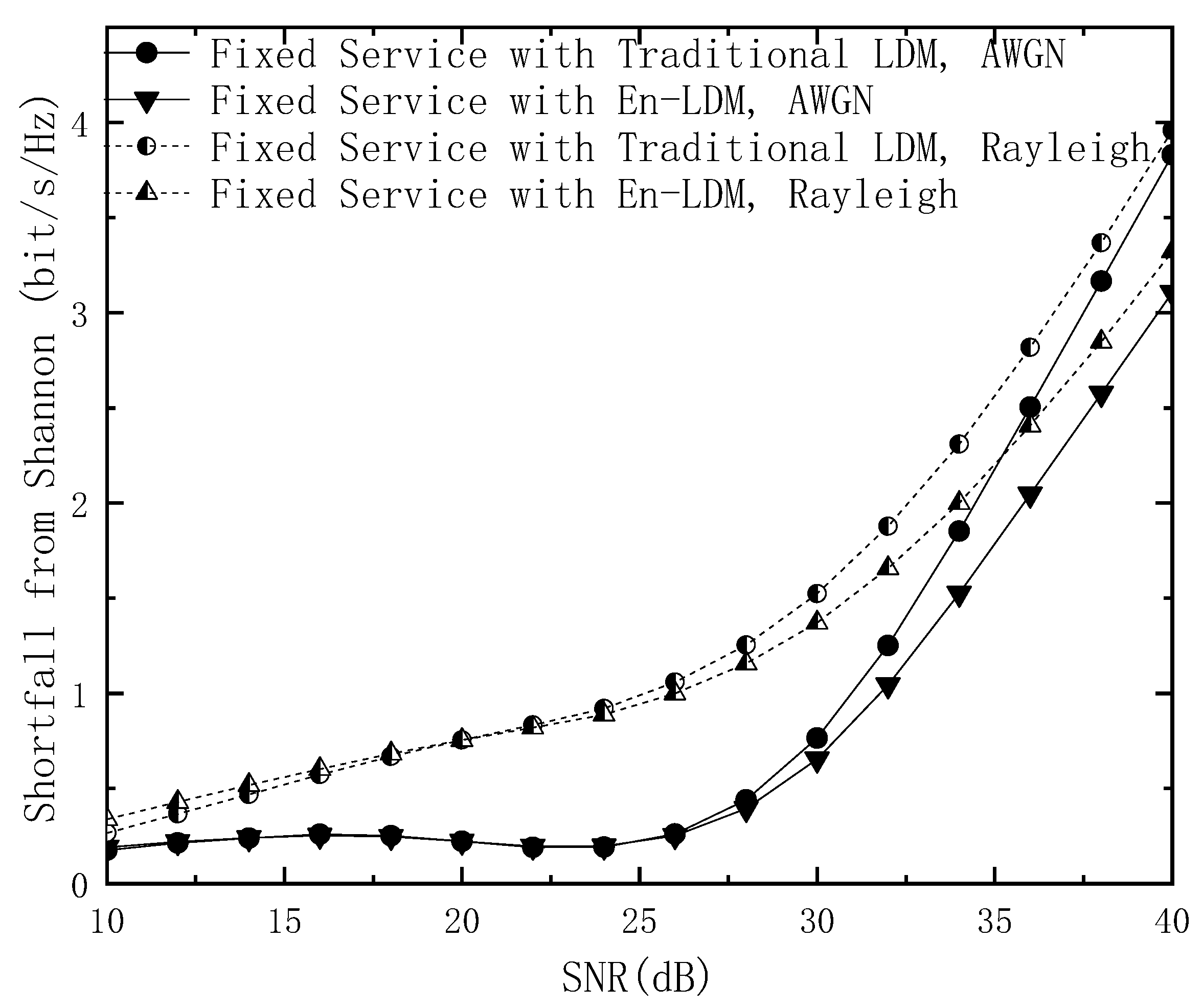
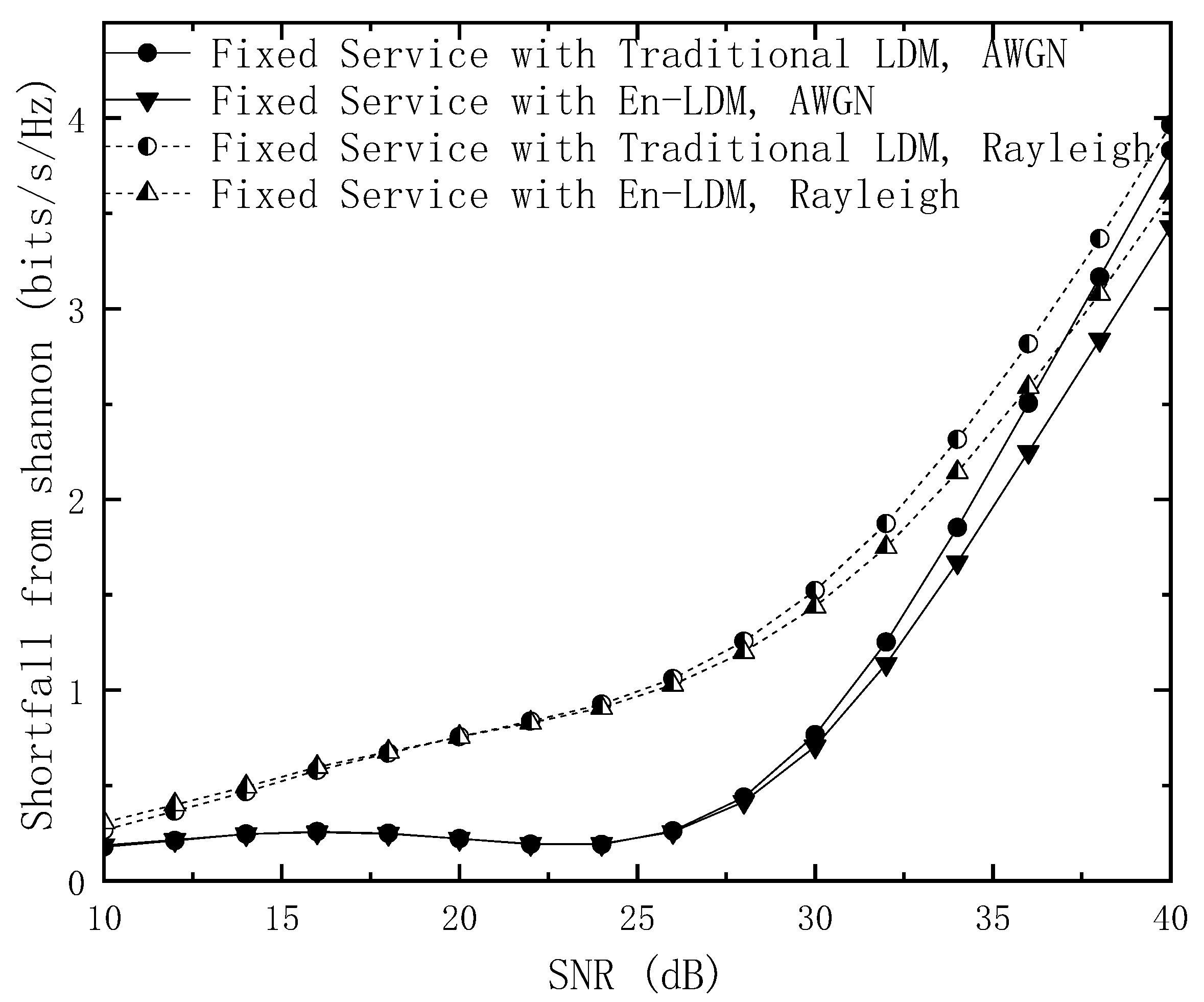

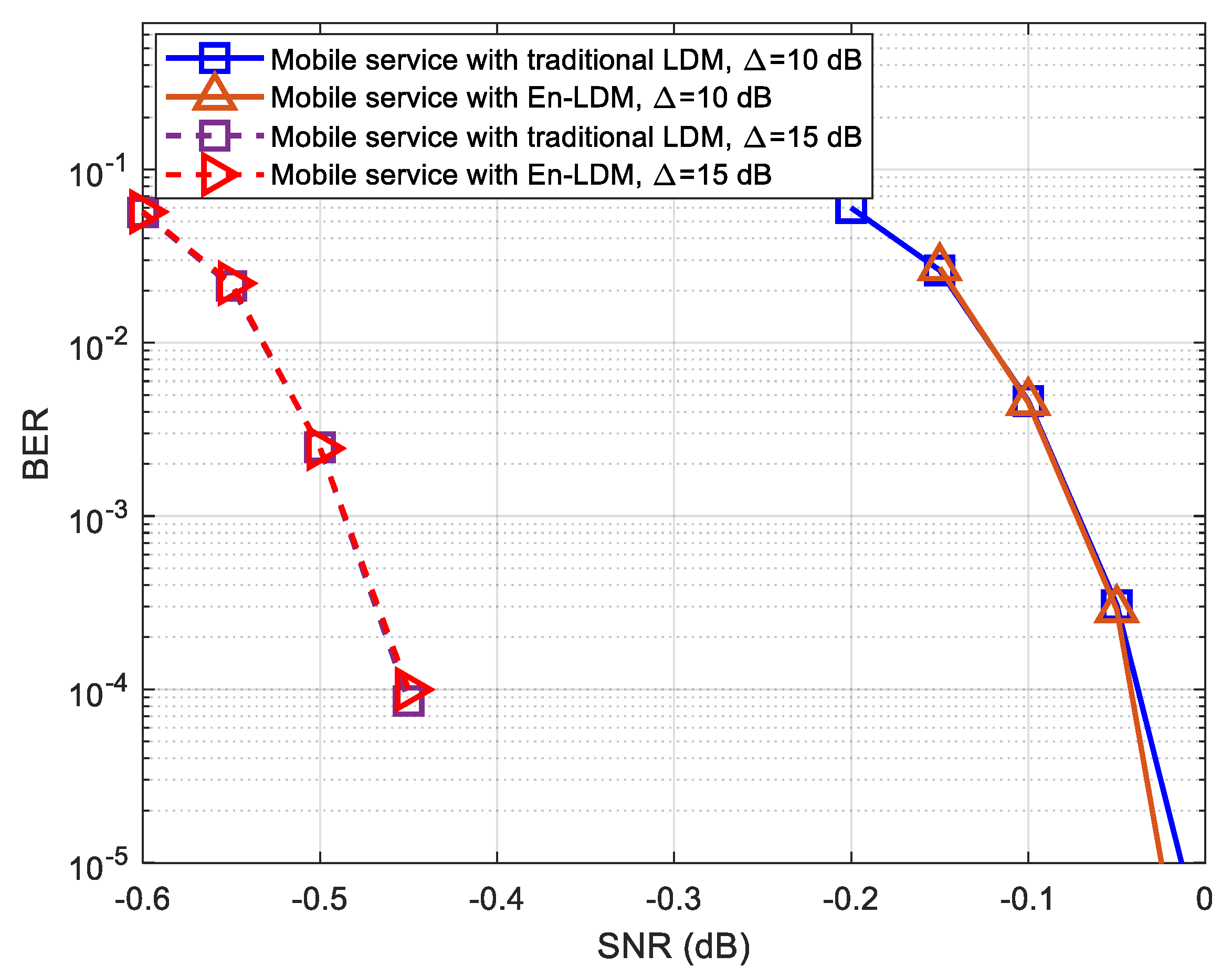
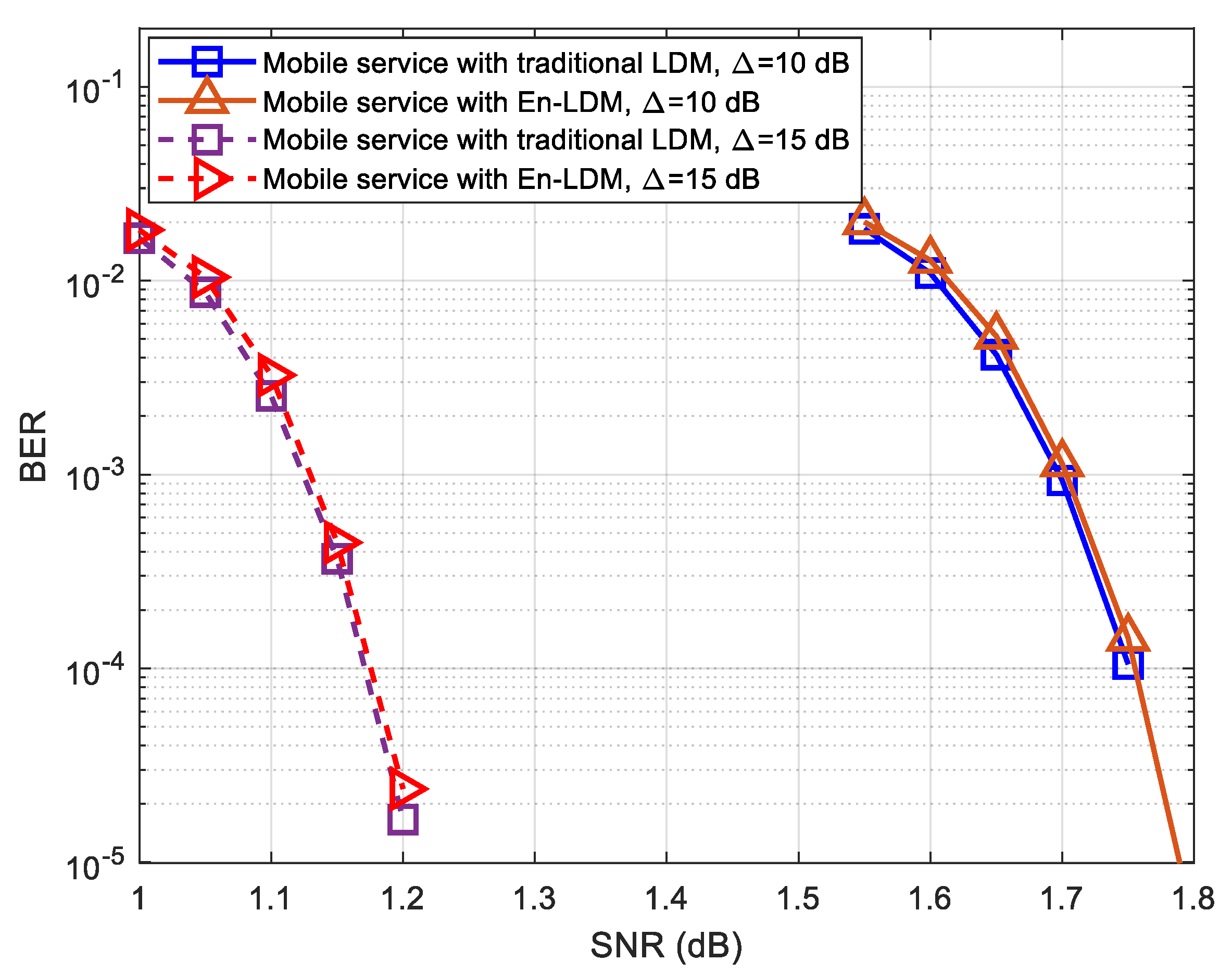
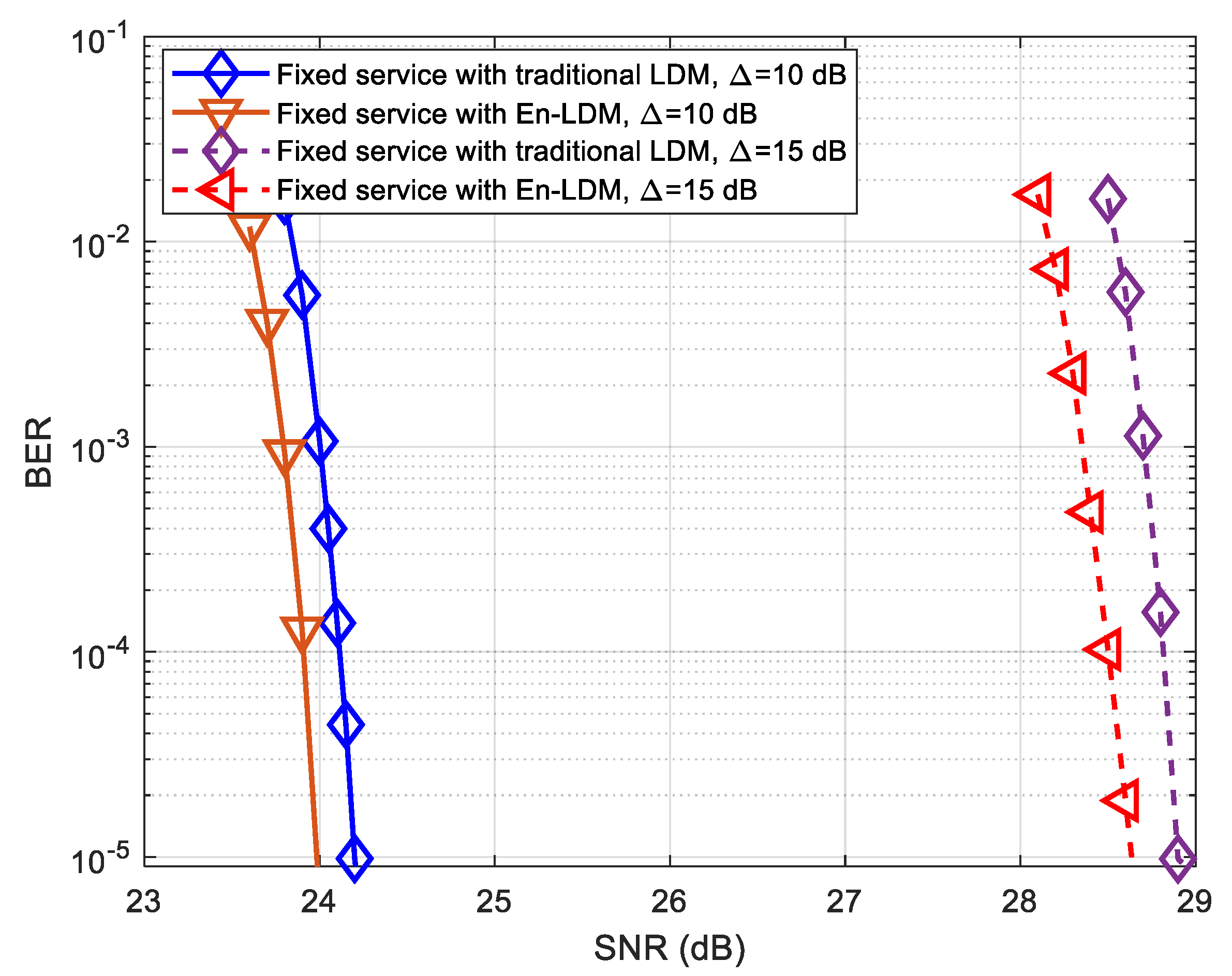
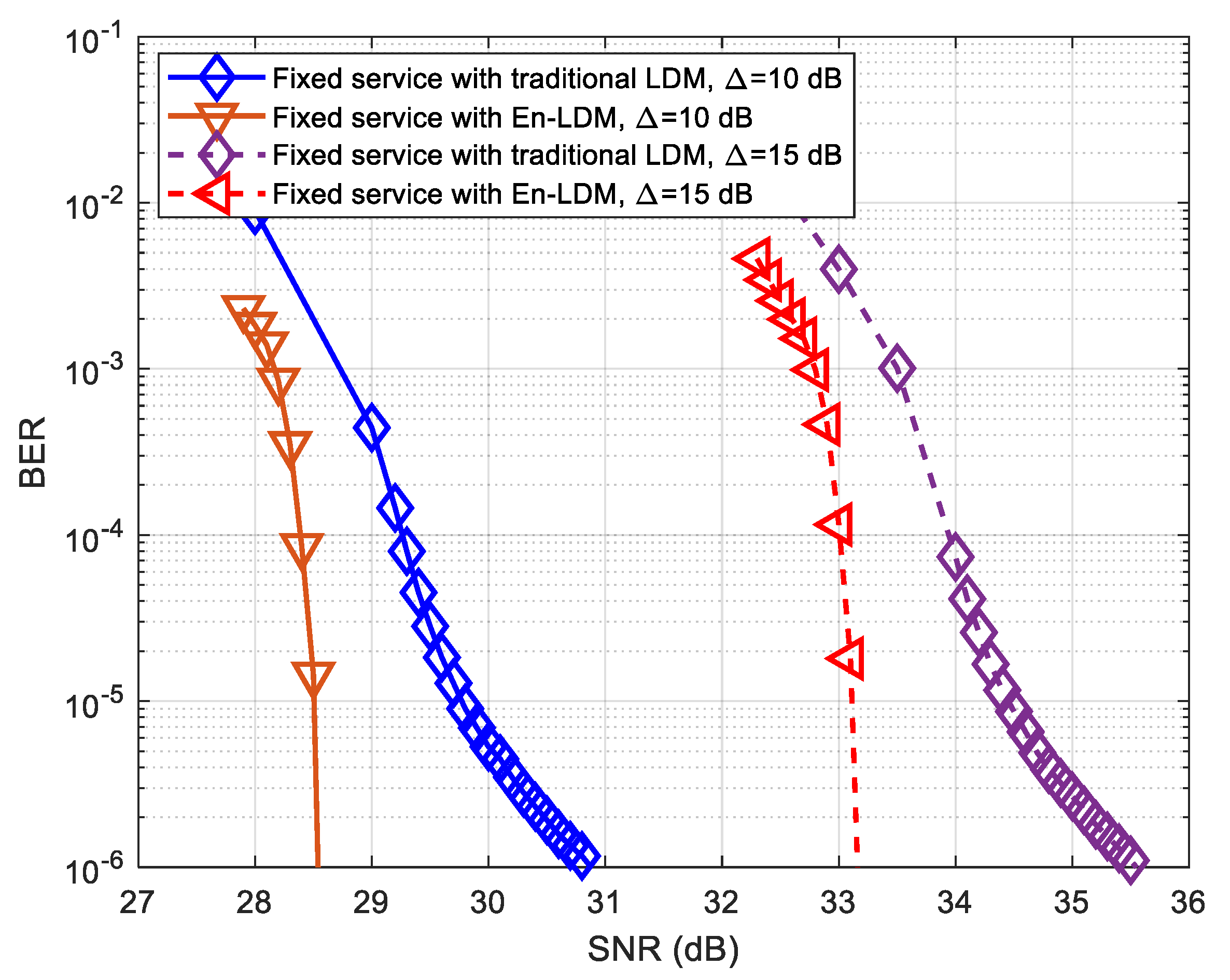

| Scheme | Transmitter | Receiver | Achieved Capacity | Complexity |
|---|---|---|---|---|
| LDM | LDM | SIC | low | low |
| LTDM [22] | LDM, TDM | SIC | medium | medium |
| En-LDM | LDM, FDM, Punctured LDPC | SIC | high | high |
| Parameter | Value |
|---|---|
| FFT Size | 16k |
| Scattered Pilot pattern | SP8_2 |
| Cyclic Prefix (CP) | 1/16 |
| CL LDPC Code Length | 16,200 |
| CL LDPC Code Rate () | 5/15 |
| CL Number of Iterations | 50 |
| CL Constellation | QPSK |
| EL LDPC Code Length | 16,200 |
| EL LDPC Code Rate () | 9/15, 11/15 |
| EL Number of Iterations | 50 |
| EL Constellation | NU−64QAM |
| Puncturing Rate (PR, ) | 1/13 |
| Injection Level () | 10 dB, 12 dB, 15 dB |
| Echo | Power (dB) | Time Delay (μs) |
|---|---|---|
| 1 | −3 | 0 |
| 2 | 0 | 0.2 |
| 3 | −2 | 0.5 |
| 4 | −6 | 1.6 |
| 5 | −8 | 2.3 |
| 6 | −10 | 5.0 |
Publisher’s Note: MDPI stays neutral with regard to jurisdictional claims in published maps and institutional affiliations. |
© 2021 by the authors. Licensee MDPI, Basel, Switzerland. This article is an open access article distributed under the terms and conditions of the Creative Commons Attribution (CC BY) license (http://creativecommons.org/licenses/by/4.0/).
Share and Cite
Deng, X.; Bian, X.; Li, M. Enhanced LDM for Next-Generation Digital Broadcasting Transmission. Sensors 2021, 21, 1716. https://doi.org/10.3390/s21051716
Deng X, Bian X, Li M. Enhanced LDM for Next-Generation Digital Broadcasting Transmission. Sensors. 2021; 21(5):1716. https://doi.org/10.3390/s21051716
Chicago/Turabian StyleDeng, Xianzheng, Xin Bian, and Mingqi Li. 2021. "Enhanced LDM for Next-Generation Digital Broadcasting Transmission" Sensors 21, no. 5: 1716. https://doi.org/10.3390/s21051716
APA StyleDeng, X., Bian, X., & Li, M. (2021). Enhanced LDM for Next-Generation Digital Broadcasting Transmission. Sensors, 21(5), 1716. https://doi.org/10.3390/s21051716






